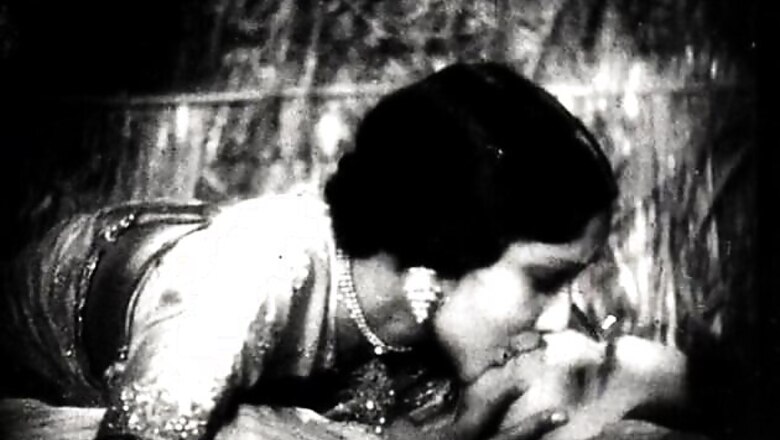
views
New Delhi: For almost four decades, Bollywood's only association with intimacy was two nodding dandelions and the camera panning to logs burning in the fireplace. Desire was portrayed through symbolism on the celluloid as filmmakers learned to fear the censor board. But this wasn't always the case in cinema's 100 year history. Actresses were as bold in the 1930s as they are today, perhaps even more.
But interestingly, only a few know that Bollywood was the boldest during its nascent stage. In the early 1920s and 30s, kissing was a common phenomenon. With Indian film industry entering its 100th year, we take a look at good, bold cinema in early years of Bollywood and how later it disappeared from the celluloid in the 1950s only to return in the late 70s.
It was in the late 80s that the filmmakers began to show content that challenged the conservative nature of the censor board.
The bold heroines of the silent era
With influence of English cinema and joint ventures with foreign production houses, the early films had a liberal dose of sex and kissing scenes. Unlike the actresses of 60s and 70s, the heroines of early 20s and 30s did not shy away from on-screen intimacy. There was a four-minute kiss between Devika Rani and her director husband in the 1933 film ''Karma', but it was actually Seeta Devi who was the first actress to lock lips on the silver screen.
In her 1929 silent film 'A Throw of Dice', Seeta Devi went on to kiss Charu Roy. Based on Mahabharata, the film is about two kings who are vying for the love of a hermit's daughter.
Another popular actress of those times, Zubeida, created a sensation back in 1932 with her scanty attire and kissing scenes in film 'Zarina'. Even Lalita Pawar, who later became popular in Bollywood for playing the vamp, had a kissing scene in 'Pati Bhakti' in 1920s.
These actresses broke new ground in the male-dominated film industry. They moved away from the shackles of conservatism and carved a path for themselves during the initial days of Bollywood.
Censorship in late 1940s
Till the mid 40s, Hindi films freely used bold content but with independence from British rule in 1947 and the establishment of the Film Advisory Board, the industry became more conservative. With the new found freedom, the Board wanted the filmmakers to present India in its chaste form. And most of celluloid's sensuality was made obsolete following the formation of the Cinematograph Act 1952. The Act had put a hold on kissing on-screen by calling it 'indecent'. Bollywood became discreet in showing any overt display of affection.
Symbolism takes over in 1950s-60s
With every frame of the film being scrutinized by the censor board, the filmmakers developed their own ways of portraying romance on the silver screen. If kissing and love making scenes were banned from the celluloid, the filmmakers showed intimacy on screen through symbolism. While touching of hands and caressing of cheeks was acceptable on the screen, the filmmakers used two flowers touching as the sign of kissing or coitus between couples. In the 50s and 60s, running around trees replaced kissing.
Filmmakers used fire as a symbol for desire and the popular 'Roop Tera Mastana' song from the 1969 film 'Aaradhna' showed the camera panning to burning logs to hint at lovemaking.
Boldness knocks on screen in 1970s-80s
The films of the 1950s and 60s were high on romance but the censor board prompted by a conservative society marred the creative freedom of the filmmakers. But with the dawn of 1970s, the filmmakers decided to keep up with the changing society. Director Raj Kapoor never ceased from displaying a certain sense of sexuality in his films. He either titillated the audiences by making his actresses wear a swimsuit or would show them in wet saris.
Raj Kapoor reprised the trend of kissing on screen with his 1973 film 'Bobby'. In a teenage romance drama, the director did not just make the actress wear the skimpiest of the clothes, but he also encouraged Rishi Kapoor and Dimple Kapadia to kiss on screen. Kapoor yet again made Shashi Kapoor and Zeenat Amam lock lips in the 1978 film 'Satyam Shivam Sundaram' later in the decade. He later took boldness to a new level with his film 'Ram Teri Ganga Maili'. Mandakini sitting under a waterfall, with her breasts clearly outlined through her wet saree became the most-talked-about scene in the film.
Keeping with the new found freedom on-screen, the other filmmakers also followed in his footsteps. Dimple Kapadia became the new symbol of sexual liberation in the mid-80s when she kissed Rishi Kapoor in the 1985 film 'Sagar' and later her steamy romance with Anil Kapoor on-screen in 'Janbaaz' became the talk of the town.
Dancing diva Madhuri Dixit also kissed Vinod Khanna in the 1988 film 'Dayavan'. Even new kids on the block in late 1980s, Juhi Chawla and Aamir Khan shared a kiss on screen in 'Qayamat Se Qayamat Tak'.
Bold gets bolder in 1990s -2010
With the advent of 1990s, kissing became a common phenomenon on the celluloid. But, it was Karisma Kapoor and Aamir Khan's minute long kiss in the 1996 film 'Raja Hindustani' that created a stir.
Taking a cue from their predecessors, the new filmmakers took boldness to a new level on-screen. In 2003 film 'Khwahish', Govind Menon made Mallika Sherawat and Himanshu Malik kiss 17 times on screen. The film was a flop at the box-office but it did get much publicity. Later many directors chose to touch on the subject of lust as an easy ticket to the box office. Neha Dhupia's 2004 film 'Julie' bombed at the box office despite her claims that sex sells in Bollywood.
But it was Anurag Basu's erotic thriller 'Murder' that created a stir in Bollywood. Emraan Hashmi and Mallika Sherawat became overnight stars with their sexual chemistry in the film. Later actors like Hrithik Roshan and Aishwarya Rai followed their footsteps in 'Dhoom 2' and Shahid Kapoor and Kareena Kapoor in 'Jab We Met' and Vidya Balan and Arshad Warsi in 'Ishiqiya'.
####



















Comments
0 comment